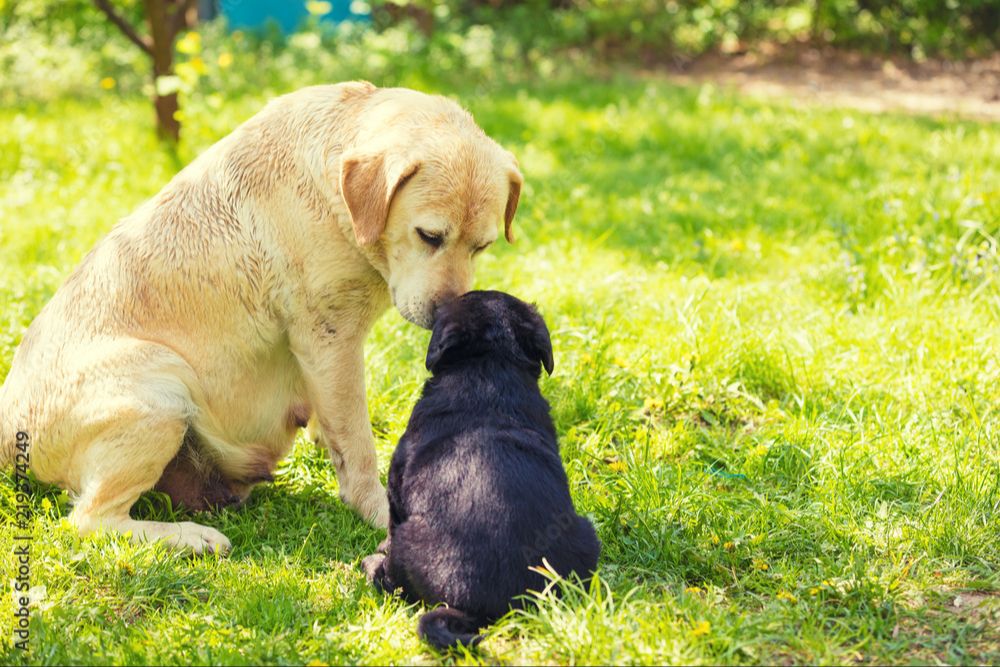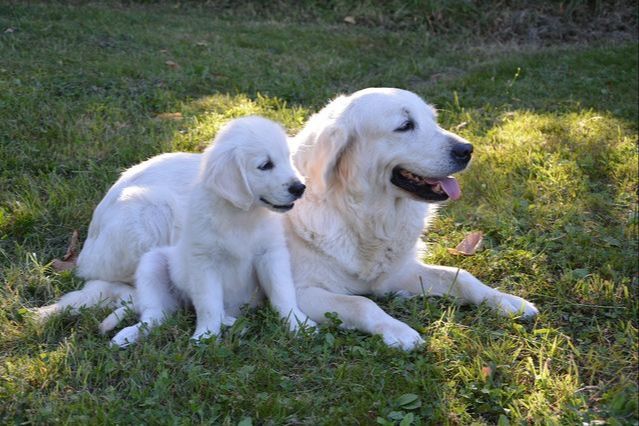Introduction
Having a mother dog and her son from the same litter continue living together into adulthood is a relatively common situation for many pet owners. However, there are a number of considerations to keep in mind when it comes to having an adult mother dog and her grown son sharing the same household.
Genetic Considerations
Breeding a mother dog with her son can increase the risk of genetic defects and health issues in the puppies. This type of close inbreeding increases homozygosity, meaning the puppies are more likely to inherit two copies of the same gene from each parent. If the gene is detrimental or a mutation, the puppies have a higher chance of inheriting that defect.
According to Embark, offspring from a mother-son mating have a 25% chance of inheriting two bad copies of mutations carried by the son. Other potential issues include:

- Birth defects
- Weakened immune system
- Shorter lifespan
- Increased risk of disease or illness
The closer the genetic relationship between the parents, the more likely that recessive traits and genetic conditions will emerge in the puppies. It’s best to avoid mating dogs that are closely related to reduce the chances of inherited health problems.
Behavioral Challenges
One major behavioral challenge that can arise when mother and son dogs live together is the son dog becoming too attached to his mother. According to Wag Walking, some male dogs will exhibit what’s called a Peter Pan syndrome where they act overly dependent on their mothers well into adulthood. This can lead to needy, attention-seeking, and clingy behavior from the son dog.
Additionally, the mother dog may enable this over-attachment by continuing to nurture and baby the adult son dog. This inhibits his ability to become independent and develop normal social skills with other dogs. The mothering behavior may also frustrate the son dog and cause acting out or aggression from the stress.

To discourage an unhealthy attached relationship, the mother and son dogs will need to be separated for periods of time. The son dog should also be socialized with other dogs and people to support independent and confident behavior. With proper training and boundaries, co-habitation may be possible over time.
Spaying/Neutering
One of the most important considerations when housing mother and son dogs together is spaying/neutering to prevent mating. According to the ASPCA, spaying or neutering your pets provides major health and behavioral benefits like preventing certain cancers, eliminating the risk of accidental litters, and reducing aggression between dogs (Spay/Neuter Your Pet). Neutering male dogs prevents testicular tumors and may also prevent prostate problems (Five Good Reasons to Spay or Neuter Your Pet).
To safely house mother and adult son dogs together, it is highly recommended to neuter the son before sexual maturity. This will reduce the risk of mating and unwanted pregnancy. Discuss the ideal timing for neutering with your veterinarian. While spaying the mother is not mandatory, it provides additional health benefits for her.
Supervision
When mother and son dogs live together, close supervision is essential. Simply having them in the same room is not enough – focused attention and intervention is required to prevent potential conflicts (Supervising your child and dog requires more than being …). The owner needs to watch for signs of tension, aggression, or anxiety in either dog and be ready to immediately redirect behaviors before problems arise (The Right Way to Supervise Dogs and Kids).
Dogs often communicate through subtle body language that owners need to learn to spot. Erect tails, tense postures, stiff movements, or fixed staring can signal rising tensions. Owners should step in to interrupt negative interactions and redirect the dogs’ attention before aggression occurs. Proper supervision means fully focusing on the dogs, not being distracted, so that warning signs don’t get missed.
Having mother and son dogs together requires an attentive, discerning, and proactive owner to troubleshoot potential issues through timely interventions. Close supervision is essential to making the living arrangement work smoothly.
Separation Anxiety
Separation anxiety is a real concern when raising mother and son dogs together. Puppies naturally form strong bonds with their mothers from birth. Separating a puppy from its mother and littermates before 8-12 weeks can lead to separation anxiety according to https://theanimalpad.org/mama-knows-best-the-dangers-of-early-separation/. The early separation from their familiar environments may result in fear, distress and impaired learning.
Likewise, an adult son dog who has always lived with his mother may develop separation anxiety if she passes away or they become separated. According to https://www.akc.org/expert-advice/training/dog-separation-anxiety/, separation anxiety exhibits as extreme stress when left alone. Symptoms include barking, howling, pacing, drooling, destructive behavior, and more. The son dog may associate the absence of his mother with danger or abandonment.
To prevent or treat separation anxiety, owners can use techniques like positive reinforcement, establishing a routine, crate training, and medications if necessary. It’s important to ease the transition and help both dogs feel secure when alone. With time, patience and proper training, the son dog can learn to be independent and confident on his own.
Housetraining

Housetraining two non-neutered dogs that are mother and son can be challenging because intact dogs tend to mark their territory more frequently with urine and feces. According to Tips on how to potty train your dog or puppy – The Humane Society, housetraining requires patience, commitment and consistency. Some tips for housetraining two intact dogs include:
- Take them outside frequently, at least every 1-2 hours as well as shortly after meals, naps, and playtime.
- Clean all accidents thoroughly with an enzymatic cleaner to remove odors that may attract the dogs back.
- Crate train the dogs separately when unsupervised so they can’t wandering and have accidents.
- Use positive reinforcement like treats and praise every time they eliminate outside.
- Limit free access to rooms in the house until fully housetrained.
Having both dogs neutered can reduce territorial marking behaviors and make housetraining easier. But neutering may not completely resolve marking habits in dogs that are already mature adults. Consistency and routine will be key to housetraining two non-neutered dogs successfully.
Fighting/Aggression
One of the biggest concerns when housing a mother and son dog together is potential fighting and aggression. Dogs who are closely related may be more likely to compete for resources and status, which can lead to conflicts. According to VCA Hospitals, “Some dogs will fight with housemate siblings throughout their lives.”
Signs that fighting or aggression could occur include tense body language, bared teeth, growling, and attacking. These behaviors may start suddenly and intensify quickly. Perpetual fighting and aggression between a mother and son dog can create an unsafe environment in the home.
To reduce chances of fighting, it’s important to spay/neuter the dogs, feed them separately, and give them their own areas for rest and play. However, fighting can still occur even with these precautions. If serious aggression arises, the safest option is likely to separate the dogs into different homes.

As VCA notes, “prevention, management, and when necessary, separation are the treatments that will result in the best outcomes for dogs and owners alike.” Before housing mother and son dogs together, seriously consider if you can properly manage potential fighting risks. Aggression issues may mean they are incompatible housemates.
When It Can Work
While there are certainly risks with keeping a mother dog and her grown son together, in some cases it can be managed successfully. This often relies on having the male dog neutered to reduce the risk of mating. However, even neutered males may still attempt to mount due to hormones and instinct. Proper supervision and separation are essential.
Some examples where mother and son dogs have coexisted without incident:
- The son was neutered at an early age, before sexual maturity.
- The two dogs are never left alone unsupervised.
- They are separated at night and other times the owners are away.
- The male is trained not to mount the mother.
- The mother asserts her dominance and discipline over the son.
With vigilance, training, and proper precautions, some owners have made it work smoothly. The risks can be mitigated, but owners should be prepared to separate the pair if issues arise.
Conclusion
In summary, mothers and sons can potentially live together but it requires careful consideration of genetics, behavior issues, spay/neuter status, and constant supervision. While closely related dogs get along in some cases, littermates often struggle with separation anxiety, aggression, and establishing a hierarchy. Thorough training, vigilance and preparedness to separate them is essential. This living situation demands an experienced owner and appropriate home setup. While rewarding for some, the risks mean it won’t work for everyone. Always put the dogs’ welfare first when deciding whether to attempt this arrangement.